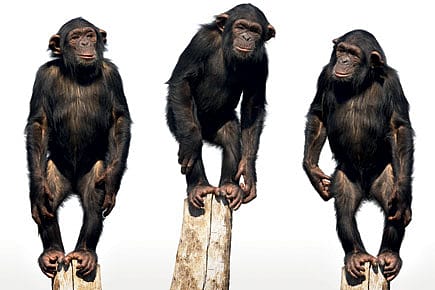We Walk to Keep Our Hands Free

Also why chimpanzees prefer being on two legs while carrying a scarce resource
An international team of researchers, including Brian Richmond at George Washington University, has discovered that human bipedalism, or walking upright, may have originated millions of years ago as an adaptation to carrying scarce, high-quality resources. In their research, published in this month's Current Biology, they studied the behaviour of modern-day chimpanzees as they competed for food resources.
"These chimpanzees provide a model of the ecological conditions under which our earliest ancestors might have begun walking on two legs," says Richmond. "Something as simple as carrying, an activity we engage in every day, may have, under the right conditions, led to upright walking and set our ancestors on a path apart from other apes that ultimately led to the origin of our kind."
According to a university press release, the research findings suggest that chimpanzees switch to moving on two limbs instead of four in situations where they need to monopolise a resource. Standing on two legs allows them to carry much more at one time because it frees their hands. Over time, intense bursts of bipedal activity may have led to anatomical changes that in turn became the subject of natural selection where competition for food or other resources was strong.
The research was in part based on a study in Kyoto University's 'outdoor laboratory' in a natural clearing in Bossou Forest. Researchers allowed the wild chimpanzees access to different combinations of two different types of nut—oil palm nut, which is naturally widely available, and coula nut, which is not. The chimpanzees' behaviour was monitored in three situations: (a) when only oil palm nuts were available, (b) when a small number of coula nuts was available, and (c) when coula nuts were the majority available resource.
2026 New Year Issue
Essays by Shashi Tharoor, Sumana Roy, Ram Madhav, Swapan Dasgupta, Carlo Pizzati, Manjari Chaturvedi, TCA Raghavan, Vinita Dawra Nangia, Rami Niranjan Desai, Shylashri Shankar, Roderick Matthews, Suvir Saran
When the rare coula nuts were available only in small numbers, the chimpanzees transported more at one time. Similarly, when coula nuts were the majority resource, the chimpanzees ignored the oil palm nuts altogether. The chimpanzees regarded the coula nuts as a more highly prized resource and competed for them more intensely. In such highcompetition settings, the frequency of cases in which the chimpanzees started moving on two legs increased by a factor of four.
